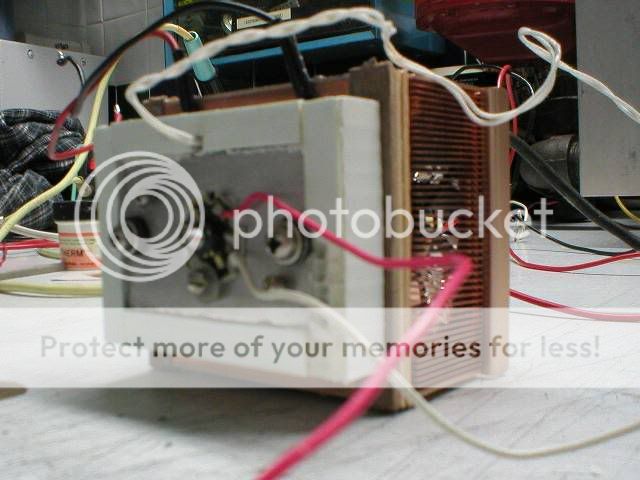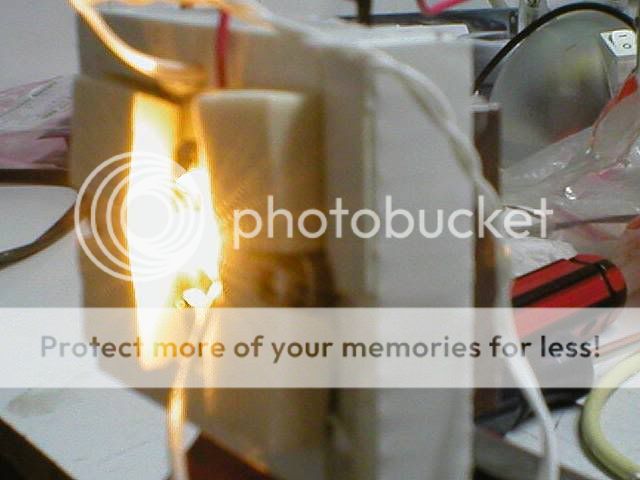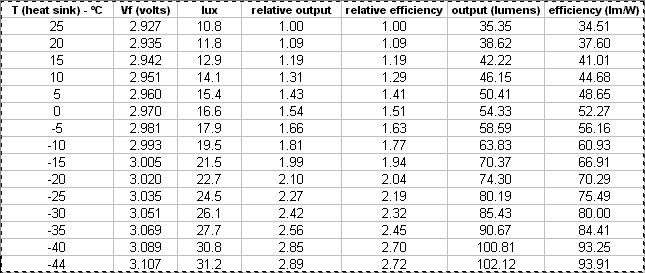jtr1962
Flashaholic
A while back someone here did some experiments cooling a red-orange Luxeon. Since the amber Luxeon is even more temperature sensitive I thought it would make for an even more interesting experiment. Enter my first attempt:

I mounted an 8.5 amp, 127 couple Nord thermoelectric module to a copper Pentium 4 heatsink into which I had drilled and tapped properly spaced holes to mount my cold block. The cold block has a hole for a transistor temperature sensor. About 8 years ago I had made a thermometer which uses ordinary transistors as temperature sensors, allowing me to easily and cheaply put temperature sensors wherever I desired. The Luxeon was screwed to the cold sink, and I applied thermal grease for good heat transfer. I drove the Luxeon via a 350 mA constant current source.
With the above setup I was able to bring the cold block with the operating Luxeon slightly below -20°C. Without the active and passive heat loads (i.e. by surrounding the cold block in insulation) I could actually reach slightly colder temperatures on the order of -25° to -27° C, depending upon the ambient temperature. Minimum temperature was reached at 5.95 amps and roughly 11.8 volts to the thermoelectric module. Any more or less current resulted in higher temperatures. Anyway, I found that the output when the cold block temperature was -20°C was more than twice the 25°C output so I decided to take these experiments to the next level.
Enter my liquid-cooled setup:

By mounting the thermoelectric module on a copper block with water channels I had made some years ago, and using tap water for cooling, I could obtain far lower temperatures, especially since tap water this time of year is about 5°C. In fact, the lowest temperatures were attained when running the module at 8.0 amps. Here are the results:

I wasn't able to go any lower than -44°C during the test because there was quite a bit of passive loading on the cold block from convection, conduction, and condensation. This was despite the fact that when the cold block was well-insulated I could get it down to almost -50°C. Note that once I got under about -15°C I had to clean the frost off the Luxeon lens immediately before taking my lux readings. The lens remained clear for a few seconds after wiping-just long enough to get good readings. Lux was measured at roughly 3 feet away. I didn't bother doing a lumens test on the LED. Since it was bin Q2G I assumed a middle of the bin lumen output of 35.35 lumens, and did the rest of my calculations accordingly. Note that at -44°C efficiency is nearly 2.75 times the 25°C efficiency. Present-day amber Luxeons with typical outputs of 42 lumens might exceed 110 lm/W efficiencies at -44°C. Even so, I thought the estimated 94 lm/W efficiency attained was amazing because it wasn't at a super low current.
I thought about cooling the Luxeon further by using a 2-stage setup but due to the heat loads observed I'm not sure I would be able to obtain much lower temperatures. Also, my -44°C lux reading doesn't seem that much higher than the -40°C. Perhaps the output increase with decreasing temperature was starting to level off, or maybe frost was building up before I could get a valid reading. I did try wiping the lens several times just to double check the results and found little difference.
What are the practical applications of this? Probably none since the power to cool the LED far outweighs any gains in efficiency. Future improved thermoelectrics might change that. For example, at -20°C the output is doubled. Assuming a total heat load of 2 watts (1.1W active and 0.9W heat leak), in theory a cooler operating with the Carnot efficiency would only require about one-third of a watt input power, yet efficiency would increase by a factor of more than two. However, present-day thermoelectrics only operate at a few percent of Carnot efficiency. I've heard of some new materials that promise greater than 50%. Even with that, it wouldn't be worthwhile cooling most LEDs. The only practical application is if you're going to light something where it's very cold all the time, amber Luxeons will probably exceed the efficiency of nearly every other light source.

I mounted an 8.5 amp, 127 couple Nord thermoelectric module to a copper Pentium 4 heatsink into which I had drilled and tapped properly spaced holes to mount my cold block. The cold block has a hole for a transistor temperature sensor. About 8 years ago I had made a thermometer which uses ordinary transistors as temperature sensors, allowing me to easily and cheaply put temperature sensors wherever I desired. The Luxeon was screwed to the cold sink, and I applied thermal grease for good heat transfer. I drove the Luxeon via a 350 mA constant current source.
With the above setup I was able to bring the cold block with the operating Luxeon slightly below -20°C. Without the active and passive heat loads (i.e. by surrounding the cold block in insulation) I could actually reach slightly colder temperatures on the order of -25° to -27° C, depending upon the ambient temperature. Minimum temperature was reached at 5.95 amps and roughly 11.8 volts to the thermoelectric module. Any more or less current resulted in higher temperatures. Anyway, I found that the output when the cold block temperature was -20°C was more than twice the 25°C output so I decided to take these experiments to the next level.
Enter my liquid-cooled setup:

By mounting the thermoelectric module on a copper block with water channels I had made some years ago, and using tap water for cooling, I could obtain far lower temperatures, especially since tap water this time of year is about 5°C. In fact, the lowest temperatures were attained when running the module at 8.0 amps. Here are the results:

I wasn't able to go any lower than -44°C during the test because there was quite a bit of passive loading on the cold block from convection, conduction, and condensation. This was despite the fact that when the cold block was well-insulated I could get it down to almost -50°C. Note that once I got under about -15°C I had to clean the frost off the Luxeon lens immediately before taking my lux readings. The lens remained clear for a few seconds after wiping-just long enough to get good readings. Lux was measured at roughly 3 feet away. I didn't bother doing a lumens test on the LED. Since it was bin Q2G I assumed a middle of the bin lumen output of 35.35 lumens, and did the rest of my calculations accordingly. Note that at -44°C efficiency is nearly 2.75 times the 25°C efficiency. Present-day amber Luxeons with typical outputs of 42 lumens might exceed 110 lm/W efficiencies at -44°C. Even so, I thought the estimated 94 lm/W efficiency attained was amazing because it wasn't at a super low current.
I thought about cooling the Luxeon further by using a 2-stage setup but due to the heat loads observed I'm not sure I would be able to obtain much lower temperatures. Also, my -44°C lux reading doesn't seem that much higher than the -40°C. Perhaps the output increase with decreasing temperature was starting to level off, or maybe frost was building up before I could get a valid reading. I did try wiping the lens several times just to double check the results and found little difference.
What are the practical applications of this? Probably none since the power to cool the LED far outweighs any gains in efficiency. Future improved thermoelectrics might change that. For example, at -20°C the output is doubled. Assuming a total heat load of 2 watts (1.1W active and 0.9W heat leak), in theory a cooler operating with the Carnot efficiency would only require about one-third of a watt input power, yet efficiency would increase by a factor of more than two. However, present-day thermoelectrics only operate at a few percent of Carnot efficiency. I've heard of some new materials that promise greater than 50%. Even with that, it wouldn't be worthwhile cooling most LEDs. The only practical application is if you're going to light something where it's very cold all the time, amber Luxeons will probably exceed the efficiency of nearly every other light source.
Last edited:



